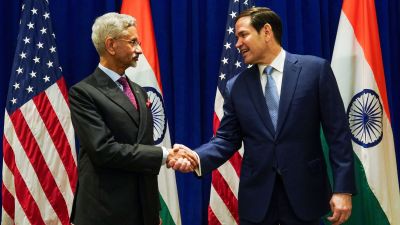Presenting the Past Modernists
A 17th century miniature style and an alien narrative may look subversive to the British critics and connoisseurs, but for twin sisters, Amr...

A 17th century miniature style and an alien narrative may look subversive to the British critics and connoisseurs, but for twin sisters, Amrit and Rabindra Kaur,it seemed the most logical course to take. End result: humourous canvases that gently upset East-West cliches.
Their latest exhibition Twin Studio Collection — Past Modern begins in the last week of July at Waterman’s Art Gallery, one of the main centres in west London
Born in a traditional Sikh family, the twins grew up in London and now live and work from Wirral, near Merseyside. Their togetherness ultimately culminated in paintings that Sunday Times art critic Robert Clarke recently described as ‘some of the most optimistic images of our multicultural world.’ Today, their paintings are part of many private as well as public collections including Tate Modern, Glasgow Gallery of Modern Art, National Museum and Royal Museum of Scotland, Art Gallery of Ontario, Canada and University of California, Santa Barbara.
The twins talk about how it all began. ‘‘On our first trip to India — in our early teens — we truly experienced what it meant to be Indian. It was a cultural awakening.’’ They decided it was time to celebrate, preserve and defend their Asian identity against expectations to assimilate into a British culture.
So what chance did two Sikh girls, painting Asian family life in a 300-year-old miniature style in the 21st century Britain, have to make it big in the British art world? ‘‘Our style was ‘unacceptable’ and the narrative ‘inappropriately’ embedded in outdated oriental aesthetics. But we were not prepared to succumb to the condescending and dismissive attitudes of our art tutors,’’ they say defiantly.
They were even downgraded in their final degree when one examiner refused to mark their dissertations that highlighted the significant impact non-European art had on the development of Western art! The choice to paint together also created a major problem — their collaborative partnership defied the idea of self-expression which is the very essence of modern art.
‘‘As British-born Asian women from a Sikh background, there are two things that motivate, inspire and inform the way we perceive our status. First and foremost is the affiliation we have with our Indian heritage; and secondly, the cultural prejudice we have encountered within the predominantly white British environment in which we have been bought up and now practice our joint career as artists,’’ they say.
Cheekily calling their style ‘past modern’, they make bold political statements within a highly decorative frame. For example, the satirical portrait of ‘Reagan and Thatcher’ quotes the composition of the miniature Jahangir Embracing Shah Abbas of Persia with just a few subtle changes. The lamb and the lion in the Mughal painting have been replaced with a mule and a vixen on their canvas, chosen to represent the personality of Reagan and Thatcher respectively.
Such a hazardous transposition of time, history and space could be controversial too. Like in the recent past their painting depicting Britain’s football star David Beckham, his pop-star wife Posh Spice and son Brooklyn as Shiva, Parvati and Ganesh did not amuse the VHP workers in Britain. ‘‘The main point of the painting was to comment on how secular icons have replaced religious ones in today’s materialistic world. And celebrities make better role models than spiritual ones. It is a sad fact of the times we live in,’’ they say, to set the record straight.
Photos


- 01
- 02
- 03
- 04
- 05





























